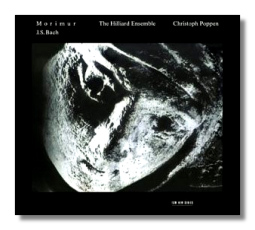
The Internet's Premier Classical Music Source
Related Links
- Latest Reviews
- More Reviews
-
By Composer
-
Collections
DVD & Blu-ray
Books
Concert Reviews
Articles/Interviews
Software
Audio
Search Amazon
Recommended Links
Site News
 CD Review
CD Review
Morimur

after Johann Sebastian Bach
Christoph Poppen, violin
The Hilliard Ensemble
ECM New Series 1765; 461895-2 DDD 61:33
If you've ever wondered what a vocal version of Bach's famous D-minor Chaconne might sound like, here's your chance to find out. This recording presents it both in its traditional version for unaccompanied violin (as an excerpt from the Partita #2), and with an overlay of voices (soprano, counter-tenor, tenor, and baritone) from the Hilliard Ensemble.
Is this mere gimmickry or self-indulgence? Actually, there's a method to this madness that makes it not so mad after all. To understand it, one needs to know the name of Helga Thoene. A musicologist and a violin pedagogue, she hunts for hidden messages in music like a German Nancy Drew. Especially in Baroque music, it is not unusual for one piece of music to quote another. Sometimes the references are obvious, and sometimes they are hidden, but it can be assumed that the composer intended something by tying one piece of music to another in this manner. (For a gross example, imagine if the first note of each measure of a new "Cantata in Praise of President Bush" spelled out the melody to "The Mickey Mouse Club Theme.") But it doesn't stop there: Thoene also is interested in numbers. Originally, it was her claim that Bach's Partitas and Sonatas for unaccompanied violin, when logically arranged in three pairs, alluded to three central events in Christian doctrine: Christmas, Easter, and Pentecost. She supported this with numerology, or what is more properly known as "gematria," which is the assignment of numbers to letters of the alphabet, and vice versa. (For example, A=1, B=2, and so on.) Remember that letters form words and also designate musical pitches, and you should be able to see where this is going. Through the application of gematric techniques, Thoene has found the "texts" to the Latin Credo and the Magnificat in Bach's music, not to mention – in many instances - Bach's own name. Of course you can't hear these gematric relationships outright, but knowing that they are there adds another level of fascination to Bach's already fascinating music.
Morimur contains moving musical examples from Bach's choral and unaccompanied violin literature, but the climaxes come in the two performances of the Chaconne. Thoene has determined that the harmonies and hidden melodies in this great movement correspond to the Easter hymn "Christ lag in Todesbanden," "Jesu meine Freude," and other works alluding to death and resurrection. Bach's name is spelled out musically (B-A-C-H; remember that, in German notation, "B" is "B Flat" and "H" is "B"), and Christ's monogram "XP" is spelled out gematrically. And so it goes. In the first performance of the Chaconne on this CD, these relationships are left implicit. In the second, with the Hilliards and Poppen together, they are made explicit.
Eerie stuff, no? All this would be of little import, however, if the music and the performances on this CD were less than they are. Fortunately, Bach's chorales and Passion movements are wonderfully realized by the vocal quartet, and Poppen's musicianship in the Chaconne (and in other movements from the Sonata #2) is outstanding. This is not an "everyday" CD, and it is not recommended for those who want a straightforward presentation of Bach's music. However, there is something very compelling, atmospheric, and beautiful about this program; might it be that way because of the composer's "numbers game"? The engineering contributes to the pervasive mood of gently shimmering love and salvation.
Bach's wife Maria Barbara died in 1720. Bach is believed to have commenced writing the Sonatas and Partitas for unaccompanied violin shortly thereafter. It makes you think, doesn't it?
About the title: "Morimur" means "we die," but in the context of the Trinitarian formula, "Ex Deo nascimur, In Christo morimur, Per Spiritum Sanctum reviviscimus." (From God we are born, in Christ we die, by the Holy Spirit we live again.) That makes you think too, no?
Copyright © 2001, Raymond Tuttle


















